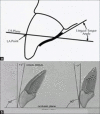Is There a Need to Increase Palatal Root Torque of Upper Incisors in Lingual Appliance? A Finite Element Analysis
- PMID: 33850396
- PMCID: PMC8035846
- DOI: 10.4103/ccd.ccd_197_19
Is There a Need to Increase Palatal Root Torque of Upper Incisors in Lingual Appliance? A Finite Element Analysis
Abstract
Objectives: To understand the effect of the biomechanical differences by assessing pre and post retraction torque, amount of retraction and arch width changes in both techniques.
Methodology: A three-dimensional geometric model of maxilla with all upper teeth except first premolar was generated based on computed tomography radiograph of a dry skull using the computer program Hypermesh. 13.0. Virtual models of 0.022 "Roth labial brackets and 0.018 "ORMCO 7th generation lingual brackets; and for labial brackets 0.019 × 0.025" SS archwire and for lingual brackets 0.016 × 0.024" SS archwire were constructed. Sliding mechanics was used during en-masse retraction by applying a 300 g distal force on both sides of the dentition from canine to the second premolar brackets in the labial and lingual simulation. The finite element program ANSYS 12.1 was used to calculate the torque and displacement.
Results: The results stipulated that in transverse direction there was lingual tipping of anteriors, mild buccal flaring in second premolars and first molars and lingual tipping in second molar in lingual appliance. In the sagittal plane, the greater distal movement of posteriors and an up-righting tendency of molars were observed in lingual appliance. Extrusion of anterior teeth were observed in both appliances. Regarding the premolars and first molars, labial movements and relative intrusion were observed in lingual appliance compared to labial appliance.
Conclusion: In lingual treatment, it is crucial to increase the lingual root torque. The amount of retraction and arch widening were more in lingual appliance compared to labial technique.
Keywords: En masse retraction; finite element analysis; labial appliance; lingual appliance.
Copyright: © 2020 Contemporary Clinical Dentistry.
Conflict of interest statement
There are no conflicts of interest.
Figures







References
-
- Roth RH. Five year clinical evaluation of the Andrews straight-wire appliance. J Clin Orthod. 1976;10:836–50. - PubMed
-
- Brodsky JF, Caputo AA, Furstman LL. Root tipping: A photoelastic-histopathologic correlation. Am J Orthod. 1975;67:1–0. - PubMed
-
- Bowley WW, Burstone C, Koenig H, Siatkowski R. Prediction of Tooth Displacement Using Laser Holography and Finite Element Techniques. Washington, DC: Proc Symp Comm V of ISP; 1974. pp. 241–73.
-
- Liang W, Rong Q, Lin J, Xu B. Torque control of the maxillary incisors in lingual and labial orthodontics: A 3-dimensional finite element analysis. Am J Orthod Dentofacial Orthop. 2009;135:316–22. - PubMed
-
- Tanne K, Matsubara S, Sakuda M. Location of the centre of resistance for the nasomaxillary complex studied in a three-dimensional finite element model. Br J Orthod. 1995;22:227–32. - PubMed
LinkOut - more resources
Full Text Sources
Research Materials
